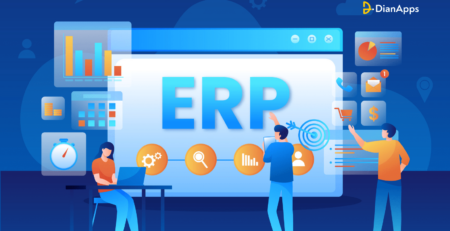Node-RED – Low-code programming for event-driven apps
The application development market is growing steadily and making simplicity a paramount subject. Creating powerful apps without the hindrance of maximum code usage is the idea emphasized by many experts.
With the continuous innovation swaying in the landscape, Node-RED has become yet another standout.
What is the purpose of Node-RED?
The open-source visual programming tool aims to collect, process, and transfer data from diverse devices over the internet, APIs, and services to streamline the complexities of coding culture.
While other programming tools create apps for different industries, Node-RED builds on-demand event-driven apps for businesses. Events, triggers, and responses—these elements define the dimension of Node-RED navigation with finesse.
This blog post gives a brief perspective on how Node-RED aligns with the principles of low-code programming to enable the creation of applications that respond dynamically to real-world events.
What are event-driven apps?
A computer program designed to react to activities initiated by a user or system is known as an event-driven application.
An event in the context of computing is any observable occurrence that matters to the hardware or software of a system. Events can be either system-generated, like a program loading, or user-generated, like a mouse click or keystroke.
The logic for handling events is kept apart from the rest of the program’s code using event-driven programming. Batch processing is in contrast with the event-driven method. Event-driven mobile app development in any programming language is a broad development strategy rather than a specific language.
In a scenario where event-driven apps are implemented, here are the steps that mobile app developers must apply:
- A user requests an action on the display
- As per the request, the event handler code will respond in the background.
- If the action requested by you is fulfilled, the event handler code precipitates other Natural code (such as subroutine) or navigates back to the control to the display screen.
Key Characteristics of Event-Driven Apps
- Asynchronous Processing: Events are handled asynchronously, enabling the mobile app development services to continue processing tasks without waiting for the completion of one action before moving on to the next.
- Loose Coupling: Components within an event-driven system are loosely coupled, meaning they are independent and can operate without detailed knowledge of each other. This enhances flexibility and scalability.
- Responsiveness: Event-driven architectures are inherently flexible as they can efficiently distribute and manage workloads. Additionally, they provide a high level of responsiveness to real-time changes.
Real-World Examples of Event-driven Scenarios
- IoT Devices: Events could be sensor readings, signaling changes in temperature, motion, or other environmental factors.
- User Interactions: Clicks, taps, and other user interactions trigger events, shaping the user experience in mobile app development services.
- Messaging Systems: Events can be messages arriving from external devices, signaling the need for processing or response.
What is low-code programming for event-driven applications?
At its core, low-code programming is a methodology that emphasizes visual development over traditional hand-coding. It allows Software app developers to design, build, and deploy applications with minimal manual coding, relying instead on a visual interface to create workflows, integrate services, and define the logic of an application.
Read our top 10 low-code platform you need to know about!
Key Characteristics of Low-Code Programming for Event-Driven Apps:
- Visual Development Environment: Low-code platforms provide a visual canvas where developers can design application logic using a drag-and-drop interface. This approach simplifies the creation of complex event-driven workflows.
- Abstraction of Complexity: Low-code platforms abstract the underlying complexity of coding, enabling developers to focus on the logic and flow of events rather than getting bogged down by intricate lines of code.
- Accelerated Development Cycle: By minimizing manual coding, low-code programming significantly accelerates the development cycle. This is particularly advantageous in the context of event-driven applications, where responsiveness and agility are paramount.
- Streamlined Integration: Low-code platforms often come equipped with pre-built connectors and integrations, simplifying the process of connecting to external services, databases, and APIs—a crucial aspect in event-driven architectures.
[Also Read: What is an API, and how can they benefit your business?]
- Empowering Citizen Developers: One of the key benefits of low-code programming is its ability to empower individuals with varying levels of technical expertise, often referred to as citizen developers, to actively participate in the application development process.
Node-RED’s Role in Low-Code Event-Driven Development:
Enter Node-RED, a champion in the low-code landscape, particularly tailored for event-driven applications. With its intuitive visual interface and a rich set of pre-built nodes representing functions and services, Node-RED allows developers to swiftly design and implement event-driven workflows.
What are Node-RED Features Needed in Low-Programming Event-Driven Apps?
Node Palette:
Node-RED comes with a rich set of pre-built nodes that can be easily drag and drop onto the canvas. These nodes represent various functions, devices, and services, allowing users to create complex applications without writing code.
Event-Driven Model:
Node-RED is for event-driven programming. It allows users to define flows that respond to events, such as messages arriving on input nodes, timer events, or external triggers. This makes it suitable for building reactive applications.
Extensibility:
Users can create custom nodes and contribute them to the Node-RED community. This extensibility enables the platform to adapt to different use cases and integrate with a wide range of devices and services.
Built-in Nodes for IoT:
Node-RED has built-in nodes for interacting with Internet of Things (IoT) devices and services. This is beneficial for creating event-driven applications in IoT scenarios without extensive coding.
[Also Read: IoT, Bots, and Mobile Apps, a victorious trident for the future.]
Integration Capabilities:
Node-RED supports integration with various APIs, databases, messaging systems, and other services. This makes it suitable for building applications that need to interact with external systems and services.
Debugging and Logging:
Node-RED provides debugging capabilities that help users understand how data flows through their application. You can add debug nodes easily to inspect messages at different points in the flow. Additionally, users can log information for debugging purposes.
Community Support:
Node-RED has a vibrant and active community. Users can find a wealth of documentation, examples, and contributed nodes to help them build their applications. Community support is valuable, especially for those who are new to programming or Node-RED itself.
How To Create Event-Driven Apps With Node-RED & DianApps?
DianApps is a software development company that has a complete team ready to create event-driven apps with the latest Node-RED version of the visual programming tool.
Here is how we can assist you:
- We will start by gathering your business requirements by scheduling a meeting with you and understanding your objectives at a personal level.
- Following that, our team of mobile app developers and product managers will identify specific use cases and functionalities that the event-driven app needs to support.
- After compiling the insights, our mobile app consultants will present the ideas that match your event apps’ expectations.
- Once the plan is ready, we proceed further with designing the user interface of the app, including the definition of events and triggers.
- DianApps’ mobile app developers will create a custom mobile app using Node-RED (open-source programming tool) to design event-driven flows.
- While also creating a visual representation of how events will trigger actions within the application.
- We add Node-RED with external services, APIs, or databases as needed by your application’s specifications.
- Meanwhile, our mobile app developers also make sure that there is seamless communication between Node-RED and other components of the app ecosystem.
- If applicable, we collaborate on the design and development of user interfaces using Node-RED’s dashboard nodes or other web-based technologies.
- We then thoroughly address and resolve issues or bugs discovered during the testing of your event-driven flows phase.
- Create comprehensive documentation for the event-driven app, including flow diagrams, node configurations, and instructions for maintenance.
- Work with the client to deploy the event-driven app to the desired environment, whether it be on-premises or in the cloud.
- Monitor the performance of the event-driven app and make optimizations as needed.
- Plan for scalability to accommodate potential increases in data volume or user activity.
By following these steps, DianApps can help its clients create robust and tailored event-driven applications using the Node-RED programming tools. The goal is to deliver a solution that meets the client’s needs, integrates seamlessly with their existing systems, and provides a user-friendly experience.
Hire our dedicated mobile app development services in the USA today!





Comments (2)
Node-red is an amazing tool! But had no idea that it can also help in build event related application. So much to learn from the blog!
Wonderfully written and expressed!